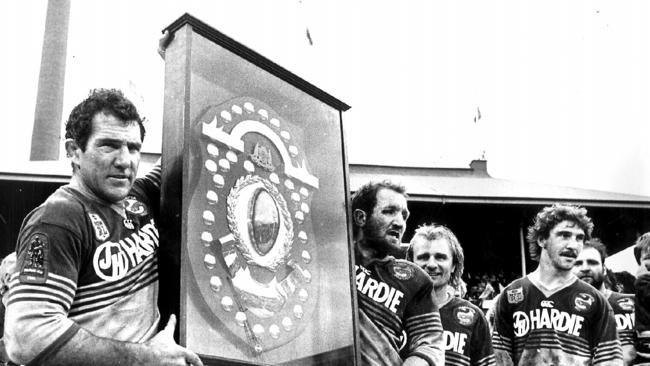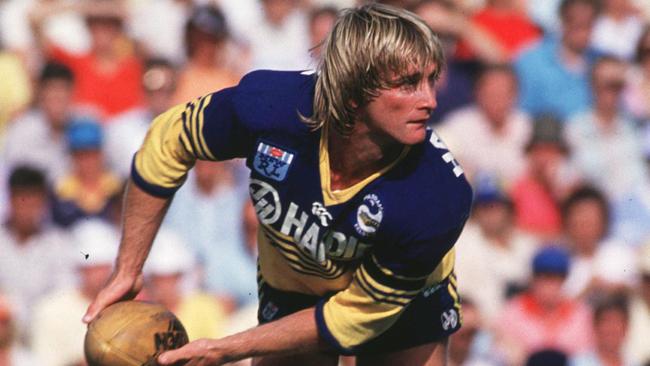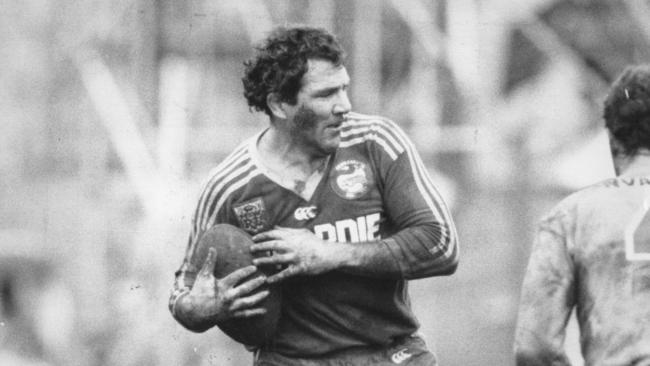Paul Crawley: Why 1986 Parramatta Eels are no match for modern giants
The Parramatta Eels were dominant in the 1980s but the size difference between the 1986 grand final champs and the giants of today is simply astonishing.
NRL
Don't miss out on the headlines from NRL. Followed categories will be added to My News.
- Buzz’s Top 50 NRL players: Million-dollar stars miss cut
TIPS.COM.AU: Over $2 million in prizes to be won
The evolution of the modern rugby league player is frightening.
Let’s take a trip down memory lane ahead of the NRL’s 2020 NRL season kick off.
We’ve pulled out the old Parramatta champions from 1986 to compare with Brad Arthur’s team today, 34 years since on from that famous 4-2 grand final against the Canterbury Bulldogs.
Watch the 2020 NRL Telstra Premiership on KAYO. Every game of every round LIVE & Ad-Break Free during play. New to Kayo? Get your 14-day free trial & start streaming instantly >

Now I’m not going to try and tell you the football was necessarily better back then, because there were parts of the game that clearly weren’t.
It was a try-less grand final for God sake, and the flamboyance, flair and speed today is mesmerising.
For good reason there is growing anticipation among Parra fans that this could finally be the year the Eels end the game’s longest running premiership drought.
While they made grand finals in 2009 and 2001, you could make a fair argument that on paper this is the best Parramatta team since the glory years.
They don’t appear to have a weakness, yet so many strengths.
A backline loaded with size, speed and strike, while the inclusion of Ryan Matterson and Reagan Campbell-Gillard improves the pack significantly.
Only time will tell if they can bring it all together, and find that game management to balance the difference between their best and worst.
FOOTY TIPS! Join Australia’s best footy tipping competition for your chance to win big. Add our experts to your league and join now at TIPS.COM.AU.

But back to what stuck out most when comparing the team of yesteryear with today.
What needs to be stipulated is that class in any era wins premierships. And the team Parra had when they last won the comp had eight internationals and a state player, as opposed to only four of this current generation who have so far experienced tier one Test footy.
Of course, in 1981 when they won their first title, it was a far better comparison from an experience level, with so many young players still to reach their limit like today.
Yet it is still quite extraordinary to look at how far physically players have come over this period with an average weight difference of 16kg between then and now.
Even scarier, try and imagine where the game might be three decades from now.
For instance, Parra’s fullback of the 80s was the little tackling machine Paul Taylor who only weighed 71kg and was 170cm, or 5ft 7in in the old scale. And Taylor often tackled in the front line because there was no wrestle.
Compare that to Clint Gutherson, who is hardly considered a giant in the modern game, but weighs 94kg and is 190cm, just short of 6ft 3in.
That makes Gutherson almost on par with the blockbusting Eric Grothe who was 95kg.
Yet the Guru was 10kg lighter than the 105kg colossus that is Maika Sivo.
The smallest man playing for the Eels in ‘86 was winger Mick Delroy who was just 68kg, an astonishing 37kgs lighter than Sivo and 33kg below Blake Ferguson.

In the centres Mick Cronin was 89kg yet seemed a giant, while Steve “Zip Zip” Ella 71.5kg. Michael Jennings is now 96kg and Waqa Blake is 98kg.
Brett Kenny was 83kg and Peter Sterling 71kg, compared to Dylan Brown and Mitchell Moses, both 85kg.
Incredibly, Moses and Brown are only 2kg lighter than Ray Price, while today’s lock Nathan Brown is 104kg.
Former Test second rower John Muggleton was only 90kg, and Mark Laurie 86kg, as opposed to Matterson, 107kg, and Shaun Lane, 110kg.
Not even the famous Parramatta bookend props Geoff Bugden, 105kg, and Terry Leabeater, 102kg, were as big as any of the forwards of today.
Back then Bugden and Leabeater were enormous, yet Junior Paulo is now 123kg and Campbell-Gillard 115kg.
It’s phenomenal how big the players have got.
Of course, standards in preparation have totally transformed the modern athlete.
Back in the 1980s they all had full-time jobs and there was very little science behind field training and how they combined with weights and diet.
If the players back then would have had access to today’s professional standards, they would have all been bigger and stronger.
Champions then would have been champions now, and vice versa.
But it does make you wonder where rugby league will be in 2050 and beyond.
With all the talk about inclusivity this pre-season and making this a game that appeals to everyone, maybe it’s time to also look deeper at where the game is heading on the field as well.

MORE NEWS
Campo’s Corner previews the Roosters, Raiders, Rabbitohs and Storm
Devastating extent of Jack Bird injury revealed
‘I look like a camel’: DWZ’s horror injury
Rugby league use to be for all body shapes and sizes. Now it is the land of the giants.
There is no way it will ever get back to how it used to be because humans are just bigger these days, and professionalism in sport is far greater than it ever was before.
But many still rightfully worry that there is just too much focus on size, and not enough on endurance.
Which brings to mind all the talk about how the new captain’s challenge will impact the game this year.
While I don’t mind the idea on principle, I wish measures had been put in place first to get rid of some of the other time wasting issues before we spend more time waiting for another video referee decision.
What I find most amusing is how they have managed to introduce such a significant rule change at short notice.
Yet it was way back in 2014 that Matthew Johns first started banging on about the need to reduce interchange to help eliminate wrestling.
Under Johns’ model, once a player left the field he could not return, like it used to be.
Not only would it open up the game, it would wrestle back some of the advantage for the little guys.
Of course, now we also have to worry about concussion and player welfare issues it might never happen.
But if it doesn’t the players will just continue to get bigger and bigger.

